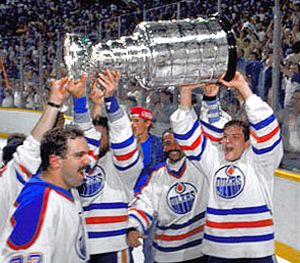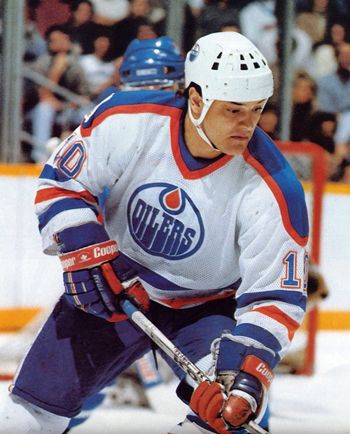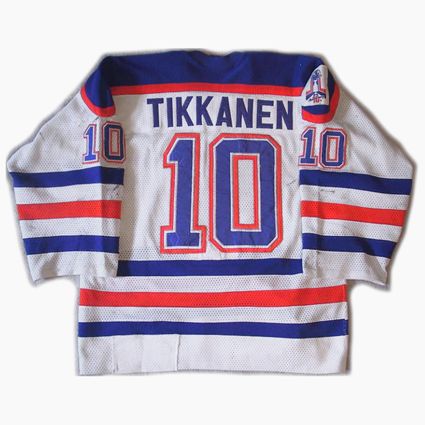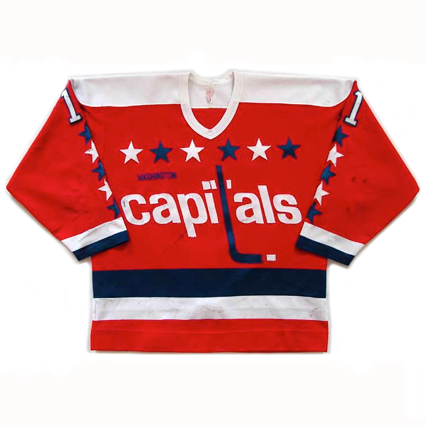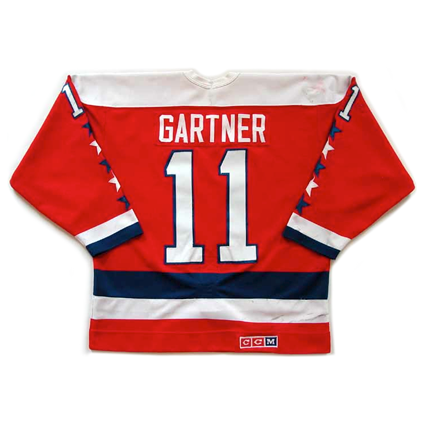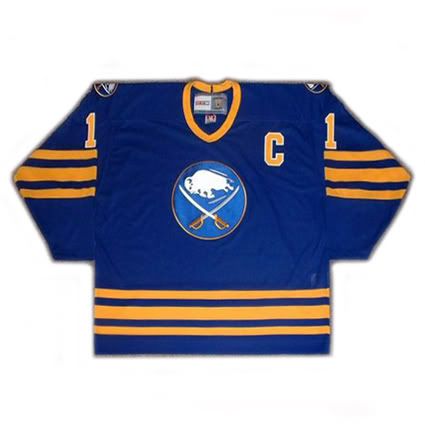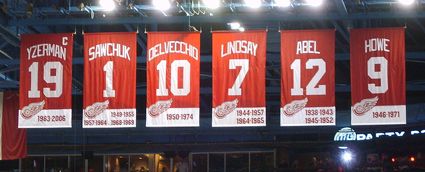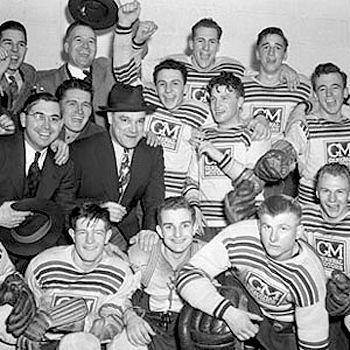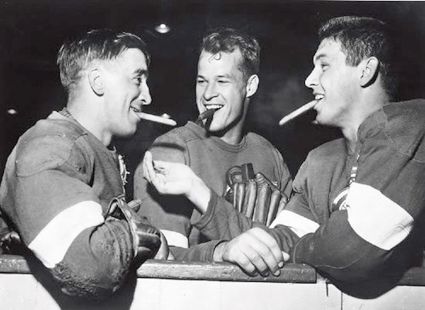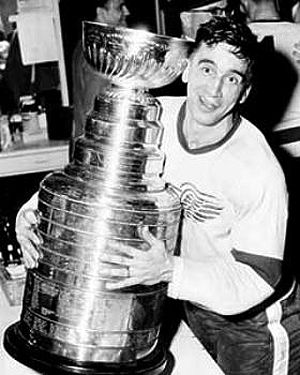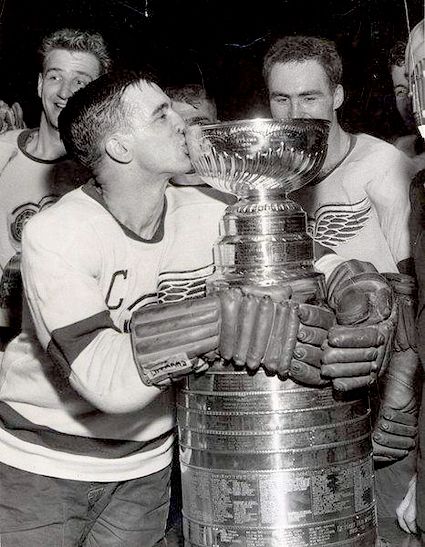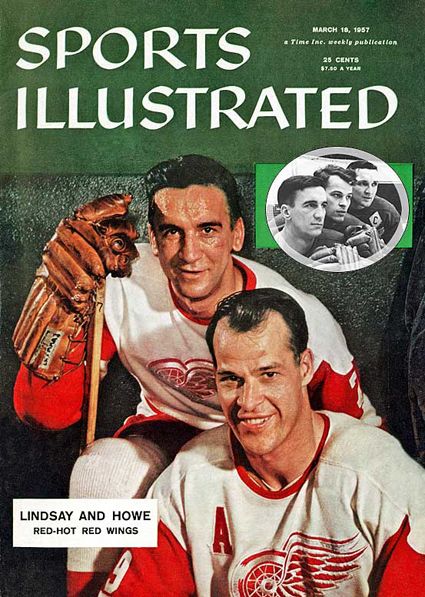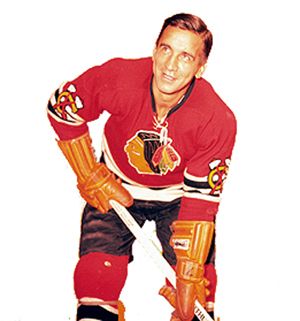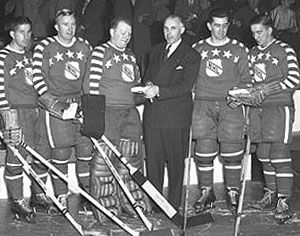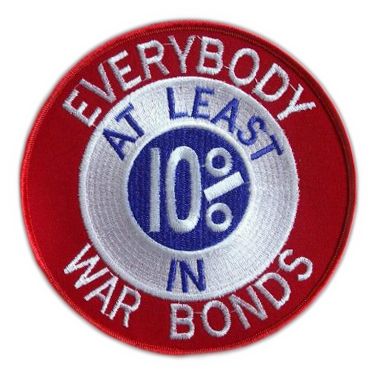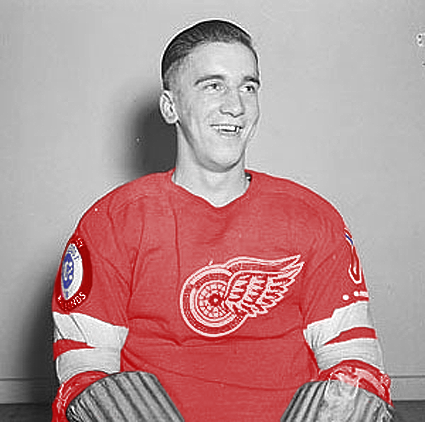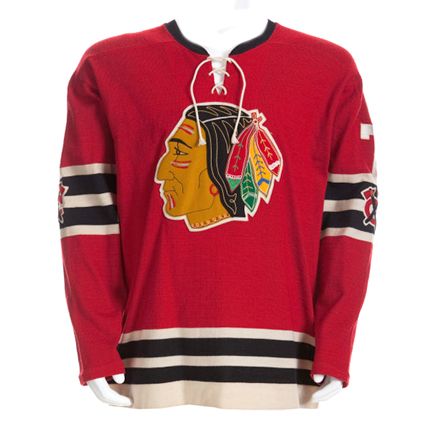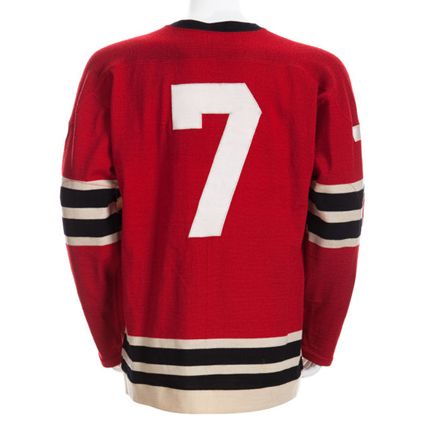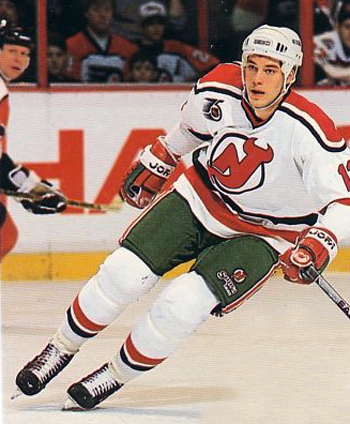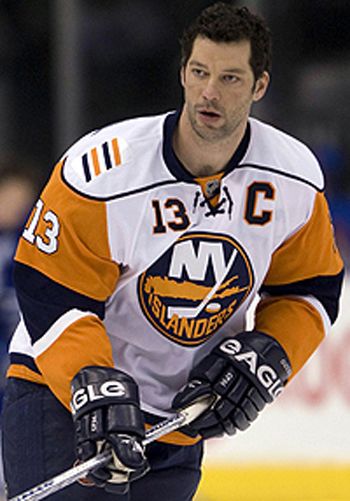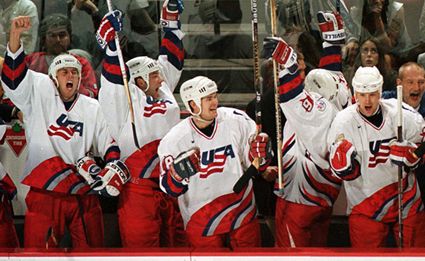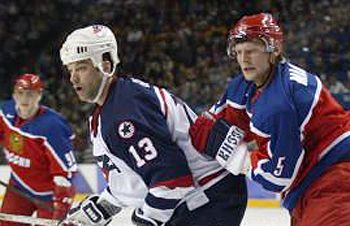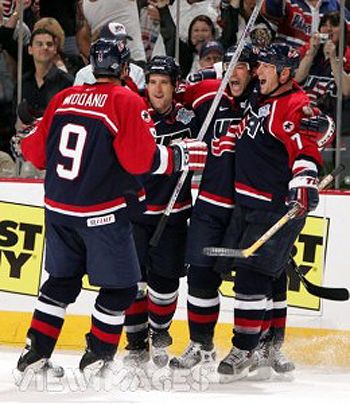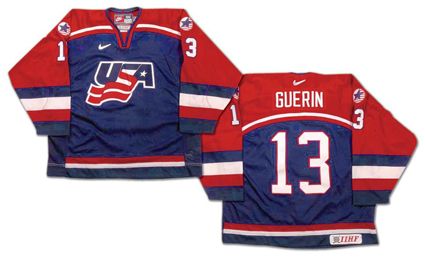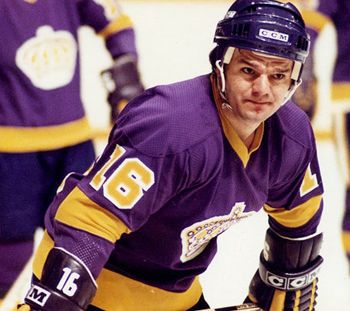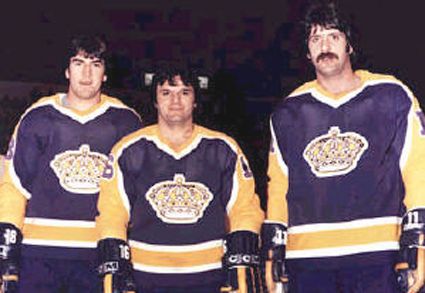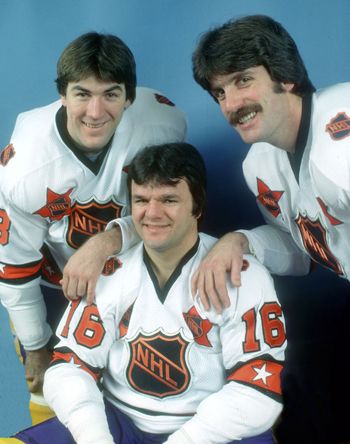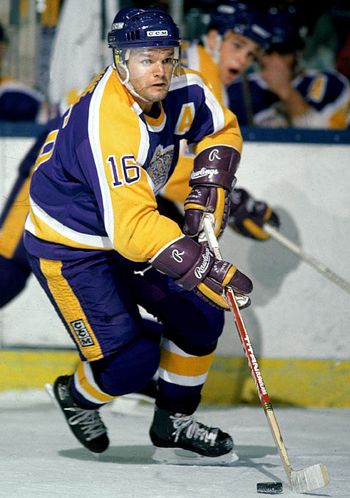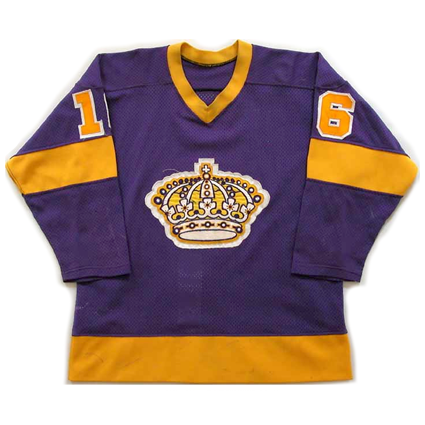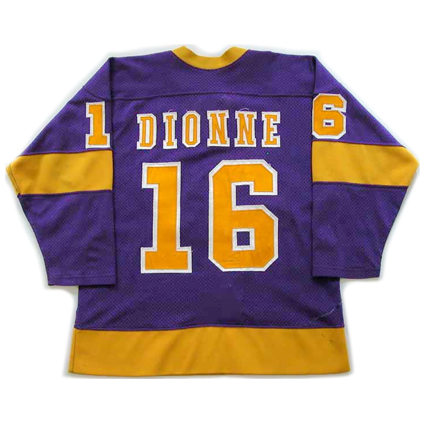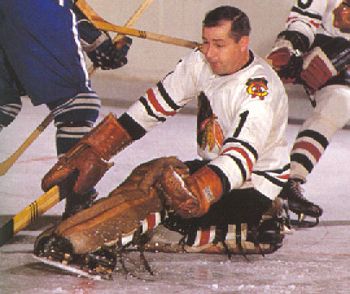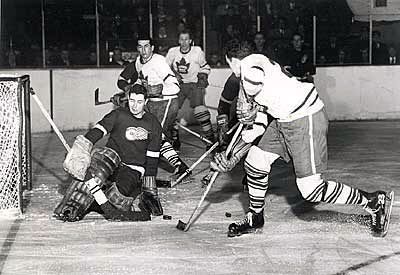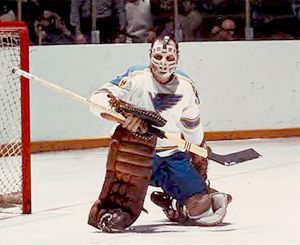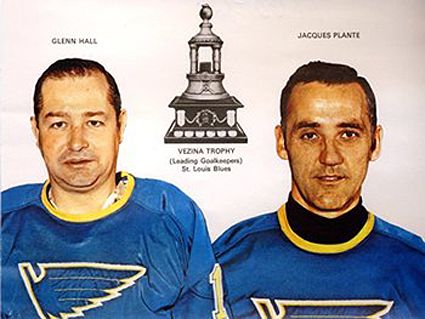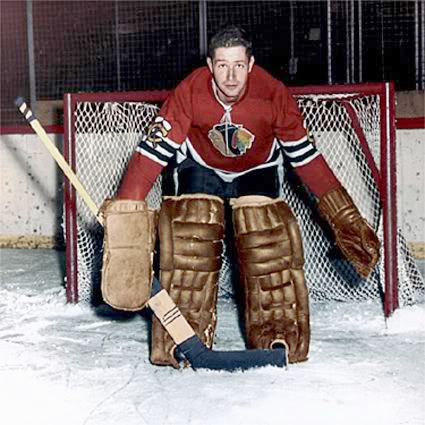Saturday, November 12, 2011
1988-89 Edmonton Oilers Esa Tikkanen Jersey
After beginning his career with HIFK in Finland, the human sandpaper that was Esa Tikkanen brought his abrasive style to the Edmonton Oilers in 1985, who were in the midst of their Stanley Cup dynasty. Tikkanen actually joined the Oilers for the first time during the Stanley Cup Finals once he was finished playing for Finland at the World Championships. He appeared in three games of the finals as the Oilers were defeating the Philadelphia Flyers, which was enough to earn Tikkanen his name on the Stanley Cup before he had ever played a regular season game in the NHL!
The following season Tikkanen was limited to 35 games with the Oilers because of a broken foot but saw time in 8 of the Oilers 10 playoff games as they were eliminated in the second round.
He was teamed on a line with Wayne Gretzky and fellow Finn Jari Kurri beginning with the 1986-87 season as the defensive member of the trio, which suited his tenacious, gritty style of play and complimented the offensive skills of his linemates perfectly. The results were immediate, as Gretzky and Kurri finished 1-2 in league scoring while Tikkanen was set up for 34 goals and credited with 44 assists for 78 points in the process while his 120 penalty minutes spoke to his feisty style of play. The season concluded with the Oilers once again regaining their grip on the Stanley Cup.
1987-88 saw Tikkanen, now known for his "Tikkanese" brand of Finnish-English hybrid language which not even fellow Finn Kurri could understand, much less the opponents Tikkanen was chirping at, repeated his offensive contributions with 74 points, but really stepped up in the playoffs with 10 goals and 27 points in 19 games as the Oilers won the Stanley Cup for the fourth time in five seasons.
During the 1988-89 season, Tikkanen set an NHL record on this date in 1988, when he scored two shorthanded goals in a span of just 12 seconds on his way to a hat trick. His pair of shorthanded goals in 12 seconds broke the previous record of 25 second held by another Oiler, Pat Hughes since 1983. Tikkanen was named NHL Player of the Week for his efforts. After missing five weeks time due to a broken left wrist, he began a point scoring streak on his first game back which stretched 13 games and proved to be the Oilers longest of the season. Despite the time missed, Tikkanen equalled his career best with 78 points despite Gretzky's departure to Los Angeles before the season. Tikkanen led the Oilers that season with eight shorthanded goals and was a finalist for the Selke Trophy as the best defensive forward.
Tikkanen recorded his third 30 goal season in 1989-90 as the Oilers regrouped behind the leadership of Mark Messier and won their fifth Stanley Cup, Tikkanen's fourth in six seasons, thanks in part to his 13 goals and 24 points in 22 games, good for fourth on the team. He was again a Selke finalist at the conclusion of the season.
Something quite remarkable happened in the 1990-91 season when Tikkanen led the Oilers in scoring, and with a mere 69 points, the first time anyone had ever led the Oilers in scoring with less than 100 points as the once dominant Oilers came back to the pack with a 37-37-6 record. Tikkanen was the runner-up for the Selke Trophy at season's end.
He missed half of the 1991-92 season, mainly due to a fractured shoulder which kept him out of action for three and a half months. For the 1992-93 season, Tikkanen played in 66 games with the Oilers, scoring 33 points in 66 games, he was traded to the New York Rangers for Doug Weight, bringing to an end the Oilers era of his career, which would continue for another nine seasons with a multitude of clubs, as he would never enjoy the kind of stability he had in Edmonton again.
Today's featured jersey is a 1988-89 Edmonton Oilers Esa Tikkanen jersey from the season Tikkanen set the NHL record for the two fastest shorthanded goals in league history.
This jersey features the Oilers 10th Anniversary patch, commemorating their time in only the NHL, as the club was actually founded in 1972, some 17 seasons earlier.
Today's video shows Tikkanen as his abrasive, trash-talking best and includes footage of him earning his reputation as one of the most disliked players in the league.
In this next clip, Tikkanen scores in overtime of Game 7 to eliminate the Calgary Flames from the 1991 playoffs during the height of the Battle of Alberta.
Labels:
Edmonton Oilers,
Tikkanen Esa
Friday, November 11, 2011
11/11/11
This being 11/11/11, we at Third String Goalie are taking a look at the best players to ever wear #11.
Notable players to have worn #11 include Bobby Carpenter, Kevin Dineen, Vic Hadfield, Walt McKechnie, Ulf Nilsson, Hall of Famer Bill Quackenbush and Charlie Simmer among many others.
Two active players wearing #11 we anticipate will have their numbers retired are Ottawa Senators captain Daniel Alfredsson and long time Montreal Canadiens captain Saku Koivu.
Alfressson has played all of his 16 seasons with the Senators and holds club records for goals, assists and points as well as games played. Remarkably, his 1,023 points are nearly twice as many as the Jason Spezza's 532. He was named team captain in 1999-00 and has remained so for 13 seasons.
Alfredsson's featured jersey is a 1995-96 Ottawa Senators jersey. This was worn during Alfredsson's rookie season when he won the Calder Trophy and has the Smitty patch in memory of Brian Smith, a Senators reporter who was murdered that year.
Koivu played 13 seasons with the Canadiens, with nine of those as team captain, tied with the legendary Jean Beliveau for the longest tenure. Koivu holds the distinction of being the first European to captain the Canadiens. Koivu overcame cancer during his career and made an emotional comeback to the game after missing nearly the entire 2001-02 season, receiving an eight-minute long standing ovation. For his dedication to hockey, he received the Masterton Trophy in 2002. He is currently 6th all-time in assists for Montreal and has also won the King Clancy Trophy for leadership qualities on and off the ice and making a significant humanitarian contribution to his community.
Koivu's featured jersey is a 2002-03 Montreal Canadiens jersey with the Hockey Fights Cancer patch worn during the season after Koivu's return from his bout with cancer.
Four players have had #11 retired in their honor in league history, the first of which was Brian Sutter of the St. Louis Blues. The oldest of the six Sutter brothers, he played 11 seasons with the Blues, the last nine of them as team captain. The season following his retirement he was named the coach of the team, a position he held for four seasons. He was known as an extremely hard working player who was responsible in the defensive zone yet still managed two forty goal seasons.
Sutter's featured jersey is a 1984-85 St. Louis Blues jersey from the only season they wore this exact jersey. This was the first season with the "Blues" script above the team logo, and for the next two seasons with the script logo, red trim was added to the jersey.
Mike Gartner had his number retired by the Washington Capitals after spending the first 10 of his 19 seasons with Washington. He is sixth in games played for the Capitals, second in all time Capitals goals, assists and points. He would go on to play with the Minnesota North Stars, New York Rangers, Toronto Maple Leafs and Phoenix Coyotes in a career that would include 1,432 games played, 708 goals, 627 assists and 1,335 points. He was known for his blazing speed and holds the NHL record with 15 consecutive seasons of 30 goals or more and the most 30 goal seasons with 17. Gartner was only the fifth player to reach 700 goals for a career, was the 1993 NHL All-Star Game MVP and was inducted into the Hockey Hall of Fame in 2001.
Gartner's featured jersey is a 1985-86 Washington Capitals jersey. This jersey features the five stars down the sleeves, which the Capitals jerseys had from 1974-75 until 1982-83 until going to just four stars for two seasons until reverting back to five again for the 1985-86 season.
The next player to have his #11 lifted to the rafters was Buffalo Sabres legend and cornerstone, Gilbert Perreault. He was the franchise's first ever draft pick, taken first overall in 1970 thanks to a spin of a wheel which came up #11, giving the Sabres the first pick in the draft.
Perreault would play 17 seasons in Buffalo and is widely regarded as one of the most gifted and skillful playmaking centers to ever play the game. He would win the Calder Trophy and Lady Byng Trophy during his career. Despite retiring in 1987, he still holds franchise records for games played, goals, assists and points as well as game winning goals and shots on goal. He is the only Sabre with over 500 goals and his 1,326 points are over 500 more than the next highest Sabre. He was team captain for five seasons and is the only Sabre to ever wear #11. Perreault was inducted into the Hockey Hall of Fame in 1990.
Perreault's featured jersey is a 1983-84 Buffalo Sabres jersey. The Sabres played with essentially the same jerseys from 1970 to 1996 with only slight variations, such as eliminating the original tie-neck collars in 1978, the same year they added shoulder logos.
This jersey proved so popular with the Sabres fans that it was brought back as a third jersey in 2006-07 and was modernized for a new third jersey again in 2008, which then became the primary jersey in 2010.
The best player to ever wear #11 has the distinction of having his number retired by two different teams. Mark Messier is known as one of the greatest leaders in hockey history ranks second on the all-time list in points, playoff points and games. He won six Stanley Cups, five with the Edmonton Oilers and a memorable one with the New York Rangers to end their 54 year drought.
He played the first 12 seasons of his career with the Oilers, three of which were as team captain. After five championships with Edmonton, Messier moved to the New York Rangers for six seasons, all of which were as team captain. When the Rangers won the Stanley Cup in 1994, Messier became the only man in league history to captain two different teams to the championship. After leaving the Rangers he moved to the Vancouver Canucks for three seasons as captain before returning to the Rangers for a second time, where he would spend the final four seasons of his 25 year career.
During his career he won the Hart Trophy twice, the Conn Smythe Trophy and the Pearson Award twice. He played in 16 NHL All-Star Games. The Rangers retired his #11 in 2006 and the Oilers did the same in 2007. Messier was inducted into the Hockey Hall of Fame in 2007.
Messier's first featured jersey is a 1989-90 Edmonton Oilers jersey as worn on May 24th, 1990 as he was awarded the Stanley Cup after a 4-1 victory over the Bruins in Boston. It was the first and only time that the Oilers would win the cup in their blue road jersey.
This jersey also features the 1990 Stanley Cup Finals patch on the left chest, only the second time the finals patches were worn, and the first time in it's now traditional location on the right chest.
Messier's second featured jersey is a 1993-94 New York Rangers jersey as worn when Messier famously was handed the Stanley Cup after leading the Rangers to the championship. The Rangers are the only team to wear the patch on their right shoulder due to the diagonal RANGERS cresting on the front of the jersey interfering with the standard location on the right chest.
Thursday, November 10, 2011
1944-45 Detroit Red Wings Ted Lindsay Jersey
On this date in 1991, the Detroit Red Wings held a pregame ceremony where they retired Ted Lindsay's #7 sweater as well as the #10 of Alex Delvecchio.
Lindsay's #7 hangs in the rafters of Joe Louis Arena with the other Red Wings honored greats
After growing up the son of a goaltender who once played for the storied Renfrew Millionaires, Lindsay played junior hockey for the St. Michael's Majors before joining the Oshawa Generals in time to win the 1944 Memorial Cup.
Ted Lindsay and the 1944 Memorial Cup champion Oshawa Generals
Lindsay joined the Detroit Red Wings for 1944-45 and had a couple of average seasons to begin his career, 23 points and then just 17 in 1945-46, but then the following year Lindsay was put on a line with veteran Sid Abel and a rookie named Gordie Howe and his career shifted into high gear.
The line was dubbed "The Production Line" based on their offensive output, which saw Lindsay's point totals jump from 17 to 42 and then continue to rise to 52 to lead the Red Wings in scoring and the entire league in goals with 33. His point total rose to 54 in 1948-49 before a quantum leap to 78 points in 1949-50 to win the Art Ross Trophy for leading the entire NHL in scoring as Howe and Abel came in second and third, giving the line a 1-2-3 standing in the scoring race. "Terrible Ted" also was third in the league with 141 penalty minutes, just three back of the league leader.
Note the unusual treatment of the assistant captain's "A" contained in the diamond shape
In the playoffs, the Red Wings outlasted the Toronto Maple Leafs in seven games and then duplicated the feat against the New York Rangers to win the first Stanley Cup of Lindsay's career. In both series Detroit won Game 7 in overtime.
Lindsay celebrates with the Stanley Cup
The Red Wings would again capture the Stanley Cup two seasons later in 1951-52 after Lindsay had the second 30 goal season of his career. In 1952-53, he would again top 30 goals with 32 and 70 points for the second time with 71. After the departure of Abel, Lindsay was named captain of the Red Wings, a position he would hold until 1956. It was during this time period that Lindsay began the tradition of the captain of the winning team lifting the Stanley Cup and skating it around the ice in celebration, a scene now repeated every year.
Captain Lindsay with the 1954 Stanley Cup
The 19954-55 Red Wings would finished first overall in the league for the seventh consecutive season and go on to take the fourth Stanley Cup of Lindsay's career. While he was limited to just 49 games of the regular season in 1954-55, snapping his 20 goals/40 points streak at 8 seasons, he was healthy in time for the playoffs where his stellar 19 points in 11 games contributed greatly to Detroit winning the second of back-to-back championships.
The time he missed also interrupted his consecutive streak of 100 penalty minutes or more streak, the only one of ten seasons he was under the century mark. So rough was Lindsay's style of play that penalties had to be created for elbowing and kneeing! He also acquired more than 400 stitches during his career before losing track.
in 1956-57, Lindsay had the greatest offensive season of his career with 85 points, this coming from 30 goals and a league leading 55 assists, which earned him a Sports Illustrated cover.
Lindsay and Howe on the Cover of SI in the spring of 1957
He was also busy that season off the ice, organizing the NHL Players' Association. Already not on good terms with Detroit general manager Jack Adams, Lindsay's union organizing efforts saw him stripped of his captaincy and later earned him a trip out of town, as he was banished to the lowly Chicago Black Hawks, who had missed the playoffs 12 times in the previous 14 seasons, in a six team league no less! Lindsay was the NHL's third leading all-time goal scorer at the time of the trade.
While the Black Hawks would miss the playoffs in 1957-58, Lindsay would have by far his best of three seasons in Chicago in 1958-59 with 22 goals and 58 points as well as a career high of 184 penalty minutes as the Black Hawks returned to the playoffs for the first time in six seasons. He would retire after one more season with Chicago with 999 games played.
Lindsay while with the Black Hawks
After four seasons away from the ice, Adams replacement and old line mate Abel coaxed Lindsay out of retirement for the 1964-65 season. Lindsay added a final 14 goals and 28 points to his career totals as the Red Wings finished with the best regular season record in the league for the first time since his departure.
His final career totals are 379 goals and 472 assists for 851 points in 1,068 games played along with 1,808 penalty minutes. He also competed in 133 playoff games (in an era when the maximum number of games was just 14) scoring 47 goals and 49 assists for 96 points. At the time of his retirement, Lindsay was the highest scoring left winger in league history.
He played in 11 NHL All-Star Games and won four Stanley Cups. In addition to his #7 begin retired on this date in 1991, he was inducted into the Hockey Hall of Fame in 1966, but declined to attend the ceremony since it was for men only, and he wanted his wife and family to attend, a rule which was changed for the following year.
Lindsay being named a first team All-Star in 1948
In 2010 the NHL Players Association renamed the award the players vote on for their annual MVP from the Lester Pearson Award to the Ted Lindsay Award in honor of his pioneering work in forming the player's association.
Today's featured jersey is a 1944-45 Detroit Red Wings Ted Lindsay jersey. While the Red Wings jerseys have remained essential unchanged since the dawn of time, this particular one stands out for the patches worn on the sleeves during Lindsay's rookie season in the NHL.
The patch on Lindsay's left sleeve is a "V" for victory, with three dots on the left of the patch and a dash on the right (Morse code for "v") was first worn during the 1941-42 season. It remained for four seasons through 1944-45.
On Lindsay's right sleeve is a patch promoting the purchase of war bonds. First worn in 1942-43, this patch was used for three seasons through 1944-45.
After wearing a patch during 1951 to promote the 250th anniversary of the City of Detroit, the Red Wings would not wear another patch until 1975 for the franchise's 50th Anniversary.
Bonus Jersey: Today's bonus jersey is a 1958-59 Chicago Black Hawks Ted Lindsay jersey. While very similar to today's Blackhawks jerseys, note the location of the crossed tomahawks inside the sleeve stripes rather than the now traditional placement on the shoulders.
This beautiful old sweater shows just why the Black Hawks jerseys frequently finish at the top of lists of best jerseys and was worn by Lindsay during the 1959 playoffs.
Today's video section begins with Ted Lindsay's biography from the Legends of Hockey series.
In this next clip, a look back at Ted Lindsay's career first broadcast in 1978 when Lindsay was the general manager of the Red Wings.
Labels:
Chicago Blackhawks,
Detroit Red Wings,
Lindsay Ted
Wednesday, November 9, 2011
2002 Team USA Bill Guerin Jersey
Born on this date in 1970, Bill Guerin played 19 seasons in the NHL with eight different clubs, winning Stanley Cups with the New Jersey Devils in 1995 and the Pittsburgh Penguins in 2009. The 14 years Guerin went between cups is the third longest wait after Chris Chelios' 6 years and Mark Recchi's 15.
He was drafted in 1989 by New Jersey and made his NHL debut during the 1991-92 season after playing his college hockey for Boston College, just an hour and a half from his hometown of Wilbraham, Massachusetts.
During his NHL career, Guerin served as captain of the New York Islanders in 2007-08 and 2008-09 and made four NHL All-Star Game appearances in 2001 when he was the game's MVP, 2003, 2004 and 2007. He was also the first player in NHL history to score 20 goals in a season for seven different teams.
He played 1,263 games during his career, scoring 429 goals, including a career high 41 goals in 2001-02, and 427 assists for 856 points, Additionally, he racked up 1,660 penalty minutes, a testament to his tough, hard-nosed style of play.
Calculating Guerin's NHL career jersey total, he is hampered by playing so many seasons in New Jersey, but was present for the change in style from the red and green jerseys worn during his rookie season (2) to their now traditional red and black jerseys (2). While with the Edmonton Oilers he wore just the home and road (2) before moving to the Boston Bruins, who wore an alternate style (3). Guerin was present in Dallas for their great looking home and road jerseys, but unfortunately that era included the notorious "Mooterus" alternate (3). While in St. Louis with the Blues it was just the home and roads (2) but the San Jose Sharks provided an alternate for his brief stay there (3). The Islanders added a throwback for an alternate (3) and the Penguins adopted their Winter Classic jerseys as an alternate the following season (3) for a total of 23, far short of Mike Sillinger's 40, but any career that totals in the 20's is noteworthy and a sure sign of longevity.
Guerin made his international hockey debut in 1989 at the World Junior Tournament in Anchorage, Alaska where he played 7 games, contributing 3 assists. During his first season at Boston College, Guerin competed in his second World Juniors, this time in Helsinki, Finland.
After his graduation from college, Guerin played the majority of the 1991-92 season with the United States National Team, appearing in 46 games while scoring 27 points before making his NHL debut later that same season.
After playing five seasons for the Devils, Guerin returned to international competition for the first time in four years as a member of Team USA at the 1996 World Cup of Hockey, which proved to be the Americans greatest triumph since the 1980 Olympics, as the United States defeated Canada 3 games to 2 in the finals.
Guerin celebrates with his teammates on the bench at the 1996 World Cup
Guerin next skated for the United States at the 1998 Olympics in Nagano, Japan, the first Olympics to feature the NHL's best, as the league suspended it's regular season schedule for the first time to allow it's players to participate. Unfortunately, the US bowed out quickly with a 1-3 record.
Once again on home ice, the United States looked to duplicate it's success in 1960 and 1980 at the 2002 Olympics in Salt Lake City under 1980 head coach Herb Brooks. This time out, the United States started strong by winning it's group with a 2-0-1 record and then advanced with wins over Germany and a thrilling defeat of Russia to earn a berth in the gold medal game thanks to their undefeated record. After falling to Canada, Guerin and the Americans had to settle for the silver medal, but a fine showing against the world's best in front of the home fans.
Guerin and the Americans take on Russia in Salt Lake City
Two seasons later Guerin was back in the red, white and blue of the United States as a member of Team USA for the 2004 World Cup of Hockey. The US would struggle through the North American Pool with a 1-2 record, but come to life with a sound defeat of Russia 5-3 in the quarterfinals before falling to Finland 2-1 in the semifinals despite leading after two periods.
Modano, Drury, Guerin and Tkachuk celebrate a goal at the 2004 World Cup
Guerin's final international tournament would be the 2006 Olympics in Torino, Italy. With eight members of the 1996 World Cup team on the roster, it would be final tournament for the finest generation of American players. They would place fourth in Group B and were eliminated to eventual finalist Finland in the quarterfinals 4-3.
In 35 international tournament appearances, Guerin would score 7 goals (4 of those in the 2002 Olympics) and 10 assists for 17 points while earning a gold medal in 1996 and a silver in 2002.
Today's featured jersey is a 2002 Team USA Bill Guerin jersey as worn in the 2002 Salt Lake Olympics as the United States made it to the gold medal final, eventually being awarded the silver medal. Guerin's four goals tied him for second on the team after John LeClair's 6.
This style jersey made it's debut in 2002 and remained in use at the World Juniors, World Championships, Olympics and finally the 2004 World Cup until being replaced in 2005.
In today's video section, Guerin and Dallas Drake throw haymakers in one of the best hockey fights you will ever see. We're not sure what Guerin was up to before the fight, but Keith Primeau doesn't hesitate to try to get in his licks as well!
In this next clip, Guerin raises the Stanley Cup and celebrates after winning in 2009.
Finally, the Penguins hold an on ice ceremony for Guerin at the time of his retirement.
Labels:
Guerin Bill,
USA
Tuesday, November 8, 2011
1978-79 Los Angeles Kings Marcel Dionne Jersey
After entering the NHL and playing four seasons with the Detroit Red Wings, Marcel Dionne was traded to the Los Angeles Kings for the 1975-76 season and was signed to the richest deal in hockey history at the time.
Dionne brought his offensive skills to the Kings and immediately scored 40 goals and 94 points in his first season is Los Angeles. The following season he set a new personal bests with the first 50 goal season of his career with 53 and 122 points to come in second in the NHL scoring race. He was also named the recipient of the Lady Byng Trophy for the second time in his career.
The 1978-79 season saw the arrival of Charlie Simmer, who was teamed with Dionne and Dave Taylor in what would become known as "The Triple Crown Line". The line would score a point in 56 consecutive games immediately upon being formed. Dionne again raised his personal bests with 59 goals and 130 points, again coming in second in the league. His efforts were rewarded by being voted the winner of the Lester Pearson Award by his peers.
The Triple Crown Line
Dionne set a career high in points with 137 points in 1979-80 from 53 goals and a career best 84 assists to finally capture the Art Ross Trophy as the league's leading scorer, as his 53 goals were two more than NHL rookie Wayne Gretzky, who tied Dionne in points. He also received his second consecutive Lester Pearson Award that season.
In 1980-81, the Triple Crown Line became the first line in NHL history where each member recorded over 100 points, with Simmer's 105, Taylor's 112 and Dionne's 135 as Dionne returned to his usual second overall in points for the third time in five years. They were also all named to the 1981 NHL All-Star Game held in Los Angeles and rather than being introduced as individuals, they were presented as a line.
“It was chemistry because nobody had a big ego. We complimented one another and we never had a bad game because we would also pick up the slack for each other on nights when it was needed,” said Dionne
After scoring 50 goals in 1981-82, Dionne extended his streak of 50 goal seasons to five consecutive with 56 in 1982-83 which included his 500th goal on December 14, 1982. His 51 assists also pushed his run of 100 point seasons to five as well. During that season's playoffs, Dionne and the Kings pulled off the greatest comeback in NHL playoff history, known as "The Miracle on Manchester", where the Kings came from down 5-0 after two periods to Gretzky and the Oilers to win 6-5 in overtime.
Dionne's streaks of 50 goals and 100 points came to an end in 1983-84 when he was limited to 66 games, yet still managed to post 92 points. Back in top form for 1984-85, Dionne played all 80 games, and while he fell a bit short of 50 goals with 46, his 80 assists pushed his point total to 126 and he reached the prestigious 600 goal plateau. After qualifying for the playoffs for the first seven of Dionne's seasons in Los Angeles, the Kings qualified for the playoffs that season for the first time in three years, but were ousted by the Edmonton Oilers in three straight.
Despite all his offensive success, Dionne grew increasingly frustrated with the Kings lack of playoff success, having won only three first round series in his now ten seasons in Los Angeles. After personally scoring 94 points in 1985-86, after which the Kings missed the playoffs, Dionne could see the Kings were in danger of missing the playoffs yet again in 1986-87 and demanded a trade, hoping to actually inspire the Kings to make some big moves to improve the team and keep him happy. The Kings however, surprised Dionne and, to his disappointment, dealt him to the New York Rangers, bringing to a close his 12 seasons with the Kings.
The Kings would honor Dionne on this date in 1990 when they retired his #16 in a pre-game ceremony before their game with his original club, Detroit. It would be only the second number retired by the Kings.
Today's featured jersey is a 1978-79 Los Angeles Kings Marcel Dionne jersey. This was the first season the Kings wore names on the backs of this style road jersey, which were introduced back in 1967 with one color gold numbers. One season later they introduced a bolder font for the numbers, now outlined in white which remained in use for the remainder of the life of this style jersey through 1978-79, the year the names were first added.
This jersey is from the season The Triple Crown lined was formed and Dionne set personal bests in goals and points.
Here's a moment we're sure they'd all like to have back. The Triple Crown Line doing their own music video! See how long you can last...
Next, a look at Dionne's career from the Legends of Hockey series.
Here's Dionne doing a commercial for CCM hockey sticks, and for an athlete, he's not half bad in front of the camera - as long as he's not signing, that is.
Oh. My. God.
Labels:
Dionne Marcel,
Los Angeles Kings
Monday, November 7, 2011
1957-58 Chicago Black Hawks Glenn Hall Jersey
For seven seasons - day in, day out - Glenn Hall tended goal every single game, every single minute from the start of the 1955-56 season for the Detroit Red Wings and then for the Chicago Black Hawks starting with the 1957-58 season up through this date in 1962.
502 complete games in goal, 551 if you count the 49 playoff games, without ever once being pulled or given a rest - all without a wearing a mask!
In that first season of the streak, Hall was the Calder Trophy winner as Rookie of the Year while a member of the Detroit Red Wings. Surprisingly, Hall was sent, along with the union organizing Ted Lindsay, to the Chicago Black Hawks in a trade following the season.
In 1961, Hall led the Black Hawks to the Stanley Cup Championship, their first in 22 seasons. Hall was also a first or second team All-Star six times in the seven year run, no easy feat in a then six-team league against competition from Terry Sawchuk (who took over in goal in Detroit following Hall's departure), Johnny Bower, Jacques Plante, Roger Crozier and Gump Worsley.
Perhaps the closest he came to ending the streak was a puck to the face from the Toronto Maple Leaf's Jim Pappin that knocked out the only tooth he ever lost playing hockey and earned him 30 of the 250 stitches he would accumulate during his career.
Despite the end of his consecutive games streak due to a bad back, it would not deter Hall, who would go on to win the Vezina Trophy that season for the first of three times in his career and play in over 400 more games before retiring.
Hall is also known for throwing up before games, which he "credits" to being excited to play, not nerves for fear, and pioneering the butterfly style of goaltending, where a goaltender drops to his knees and spreads his legs out in a "V" shape, rather than doing the splits or laying sideways and stacking the pads on top of each other, the common styles used at the time. Keeping himself vertical also helped keep his face farther off the ice and away from the puck.
Playing with Stan Mikita and Bobby Hull was great for games, but very hard on Hall during practices. Mikita and Hull were the original developers of the curved stick and known for their blazing slap shots. Back in those days practices were not filled with the drills of today's modern practice, plus there were no rules at the time limiting the curvature on stick blades, and the players would blast shot after shot at the goaltenders, which would dip as much as two feet on their way to the net.
Hull in particular had no qualms about firing pucks at people, including trying to fire the puck at the glass in front of the goal judge at Chicago Stadium during pregame warmups to startle him into spilling his traditional coke. The problem for Hall was his location in the net in between Hull and the goal judge, requiring the puck to rip past Hall's head just over his shoulder on it's way to the glass!
Hall was set to retire at age 35, but was taken by the St. Louis Blues in the 1967 Expansion Draft, despite having just won the Vezina trophy! A 35% raise from $35,000 to $47,500 convinced Hall to extend his career. He led the Blues to the Stanley Cup Finals three years in a row and also finally began to wear a mask.
He would capture the Conn Smythe Trophy in the 1968 playoffs, despite being on the losing end of a 4 games to none sweep at the hands of the Montreal Canadiens. Each game was a one-goal victory for Montreal, with Games 1 and 3 going to overtime. Hall would also share the Vezina trophy with Jacques Plante in 1968-69.
He retired with 84 shutouts and a lifetime goals against average of 2.51. He was elected to the Hockey Hall of Fame in 1975.
Today's featured jersey is a 1957-68 Chicago Black Hawks Glenn Hall jersey from his first season in Chicago. The crossed tomahawks and C logo was still worn over the sleeve stripes at the time before relocating up to the shoulder area for the 1960 season. The jersey also has the classic tie-neck collar used through the 1964-65 season. No names were worn on the back of the jerseys in those days, just Hall's traditional goaltender's #1.
First up in todays video section is the excellent Legends of Hockey profile on Hall.
This brief video focuses on Hall's consecutive games streak.
Labels:
Chicago Blackhawks,
Hall Glenn
Subscribe to:
Comments (Atom)


